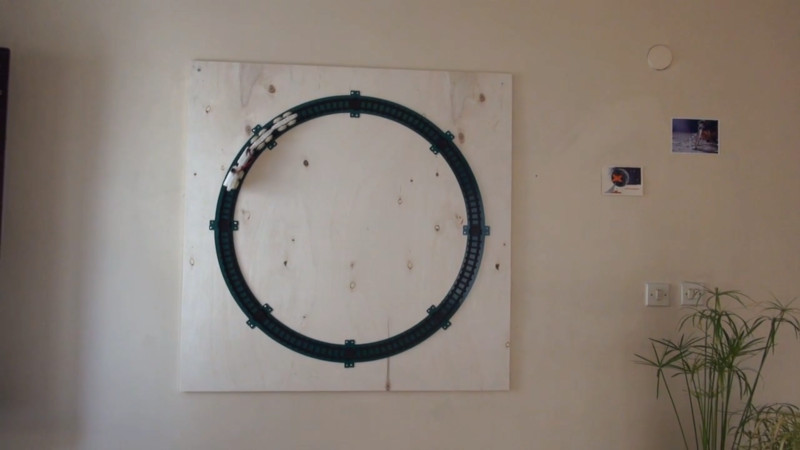Trains are great for hauling massive amounts of cargo from point A to point B, and occasionally, point C on weekends. But they’re not really known for climbing hills well, and anything vertical is right out. Regardless, [Can Altineller] knows what he wants and set to work, creating the 3D Printed Wall Train.
The first step was to get the train to stick to a vertical surface. This was achieved with the use of neodymium magnets in the train, which are attracted to laser-cut steel plates beneath the plastic tracks. The train itself consists of a custom 3D printed locomotive, outfitted with a motor and step-down gears that drive all four wheels. Said wheels are of a conical shape, and covered with rubber to provide enough grip to overcome gravity. The project is a progression from [Cal]’s earlier four-motor build.
The final result is a charming wall display, with the four-wheel drive train merrily tugging its carriages around the circular course ad infinitum. It’s a fun build, and we’d love to see similar techniques applied to a bigger layout. If this whets your appetite for model railroading, consider building your own turntable, or implementing some fancy sensors. Video after the break.
















That does look pretty cool. Imagine a more complicated layout with switches and turnouts all mounted vertically.
I remember years ago (maybe 30) having a toy car that drove up “walls”. Well much my to my mothers disgust no doubt was the “walls” meant fridge door. The wheels were magnets.
I wonder if for this train greater efficiency could be obtained using a similar system. If the wheels were magnets sticking to the rail the the force wouldn’t be applied to the axels. And the magnetic wheels would also overcome the need for rubber tyres to gain the necessary traction to drive up the wall.
“I remember years ago (maybe 30) having a toy car that drove up “walls”. Well much my to my mothers disgust no doubt was the “walls” meant fridge door. The wheels were magnets.
Modern toy cars, driving up the walls get suction force from a fan, no need for magnets.
I don’t know how but this has to be adapted into a clock.
The obvious solution would be three concentric circles.
The ‘minutes’ train would be advanced one sixtieth of the total circumference with every revolution of the ‘seconds’ train. It would also need sensors on the track every ‘five minutes’. The ‘hours’ train would be advanced one twelfth of the distance between one hour and the next every time the ‘minutes’ train reach one of the sensors.
The actual design and construction is left as an exercise for the reader :)
I was tryna brain out it doing something trainy like picking up and leaving “mailbags” for minute indicators.
Lights in the carriages that light up when it passes the hour/minute/second spots maybe.
Maybe three concentric circles, yes, but three different models: an electric representing the seconds (maybe too fast to move safely), a diesel representing the minutes, and a steam one for the hours – all of them moving constantly, but with different speeds.
A full size train air horn would also be nice to mark the full hours… :D
Haven’t played the video yet (I am at work) but I was thinking the same thing… good project for a railway enthusiast club I’d think.
That’s a rather good idea, Hirudinea.
Great choice of music. Could someone more cultured than I am remind me of the composer and name of this piece?
Sounds Handel-ish but can’t name it.
The music is “The Ruins of Athens: Turkish March” by Beethoven and as performed by Fiedler and the Boston Pops. Here’s a link for your enjoyment. 😀
https://youtu.be/fARdT-1S8F8
I’ll just leave this here:
https://www.youtube.com/watch?v=YngIuQoBRIs
(tip: mute the audio and play AC/DC’s Thunderstruck, it somehow fits! :-) )
This is nowhere near as cool as a vertical train, but just an interesting side note about magnets and trains: Lionel pseudo-O-gauge trains used something called magnetraction, where they had strong magnets inside the train that conveyed magnetic flux through the wheels into the steel rails, and claimed it increased the traction of the trains by something like 25-50%. They weren’t able to climb vertically, of course, but they could easily climb grades 5x that of what real trains could do.
I think real trains would be expected to top out around 1.5% and a generic electric model train might do 15% or 10x that, so I’d figure on those coping with double that??? 33% one in three-ish?? For 20x the gradient of real trains.
Trains can climb hills just fine with a rack & pinion system.
I have a flying car, I just have to insert it into a C5 Galaxy.
Busch-models made a similar magnetic train for the 2010 toyfair. I’ve since seen it in their catalogue, and an internet search for “busch mine starter set” brings up some resellers so it wasn’t just a one off for the show.
https://www.youtube.com/watch?v=_cI7UG1Tq54
Yay! It was my dream as a child, to build a vehicle climbing walls (-: